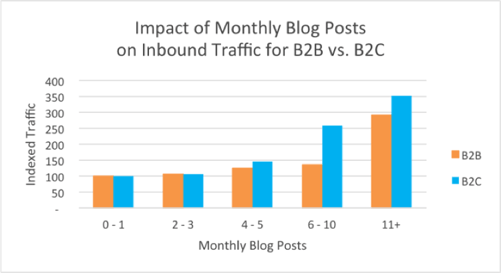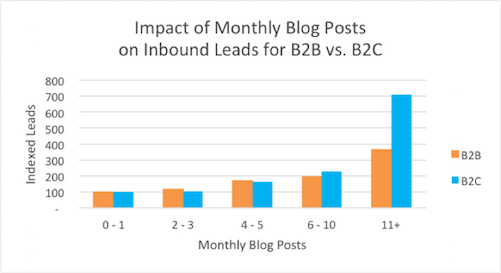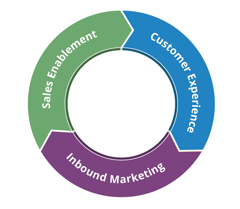Blogging has significantly evolved over the years, transforming from its humble beginnings as a simple online diary or journal used by individuals to share personal thoughts and experiences. In its early days, blogging was primarily a platform for self-expression, where people could document their daily lives, hobbies, and interests. However, as the digital landscape has grown and changed, so too has the role of blogging. Today, in the digital age, blogging has become a serious business tool for big brands and companies. These organizations leverage blogging as a powerful strategy to boost their sales and enhance their content marketing efforts. By creating valuable, informative, and engaging content, businesses can connect with their audience, build brand authority, and drive website traffic. While content marketing is often hailed as “the only marketing left,” numerous factors must be considered when implementing it effectively. One critical aspect is determining how frequently you should blog to maximize impact. In this post, we’ll delve into the importance of posting frequency and how it influences success in blogging for both B2B (business-to-business) and B2C (business-to-consumer) industries, providing insights into finding the right balance to achieve your marketing goals.
What’s the magic number in blogging?
When HubSpot conducted an extensive analysis of its 13,500 customer companies to evaluate the impact of their blogging efforts, they discovered a compelling trend. For both B2B (business-to-business) and B2C (business-to-consumer) companies, those that consistently published at least 11 blog posts per month experienced a remarkable increase in inbound traffic compared to their counterparts who published fewer posts. This finding highlights the importance of maintaining a robust and regular blogging schedule, as it directly correlates with attracting more visitors to a company's website. The data suggests that a higher frequency of quality content enhances visibility and plays a crucial role in engaging potential customers and driving them to explore more about the brand. By committing to a consistent blogging routine, businesses can significantly boost their online presence and create more opportunities for interaction with their target audience.

In this graph from HubSpot, we can see that B2B companies didn’t experience a noticeable increase in traffic until they reached the 11th blog post mark each month. This indicates that for businesses operating in the B2B sector, maintaining a consistent and frequent blogging schedule is often more crucial to drive traffic to their websites effectively. The data suggests that the potential for attracting many visitors is limited without reaching this threshold. However, it’s important to remember that page traffic alone can be misleading, as it is often considered a vanity metric that doesn’t necessarily translate into tangible business outcomes. When HubSpot analyzed the traffic conversion into leads, they found that it was only when businesses committed to publishing at least 11 blog posts per month that the increased traffic converted into valuable leads. This underscores the importance of generating traffic and ensuring that the content is engaging and relevant enough to encourage visitors to take further action, ultimately leading to successful lead generation and business growth.

More content on your blog means more chances of your visitors staying on your site longer, which is beneficial for your Google score due to a lower bounce rate. A lower bounce rate indicates that visitors are finding your content engaging enough to explore further, which can improve your site's ranking in search engine results. This increased engagement enhances your visibility and builds trust with your audience, as they perceive your site as a valuable resource. However, to achieve this, you must also dedicate time to posting frequently and ensuring that the content you create is relevant, informative, and tailored to your audience's needs. This involves understanding your target market, researching trending topics, and crafting posts that address your readers' interests and pain points. In another study by HubSpot, it was found that evergreen content—content that remains relevant and valuable over time—from blogs was responsible for generating 90% of the leads they acquired. This statistic holds for both B2B and B2C sectors, highlighting the importance of creating content that attracts initial interest and continues to draw in and convert visitors long after publication. By producing high-quality, timeless content, businesses can ensure a steady stream of leads and maintain a strong online presence.
Here’s a quick look at some factors to keep in mind when blogging for your business:
- Consistency: Yes, it’s possible that two businesses in the same industry who post differently can achieve the same level of success. Whatever posting frequency you decide, staying consistent is one of the key factors determining whether you’ll gain a following/audience. Your followers will come to expect your posts, and you’ll slowly grow a following to earn enough juice, which makes Google decide that you’re worthy enough of the first page of search results.
- Freshness: Newer, up-to-date content has a high chance of dethroning top performers in specific keywords, as is the case for Mashable overtaking a Copyblogger post with 22K backlinks. However, that doesn’t mean newer content is always better, as Brian Dean of Backlinko says, "an old post that is regularly updated can still outrank new ones."
- Quality: Content marketing got the flak for its effectiveness when blogging exploded in popularity, spawning low-quality blogs that served only to farm links. Remember that you’re blogging, first and foremost, is for your target audience, not Google. The latter will come when your content is good enough.
How often you should blog still depends on your blogging goals. Without a clear content strategy, all those blog posts are like shots in the dark where you may feel the momentum with every hit, but all you’re doing is missing your target and losing your chances to score.
When deciding how often you should blog, take inspiration from the industry statistics. For industries in both sectors, it’s best practice to aim to publish at least 11 blog posts per month to get the traction you need.
To give yourself even more leverage, get a content marketing tool so that you can come up with the correct number that suits your business blog like a glove.
Need help getting started? We invite you to schedule a complimentary inbound marketing consultation where we can discuss your current marketing initiatives, strategy, and even the process you have outlined to make sure it's a success.


.png?width=80&height=80&name=diamond-badge-color%20(1).png)
__Square.png?width=250&height=250&name=Marketing_Hub_(1)__Square.png)




.png?width=250&name=diamond-badge-color%20(1).png)
